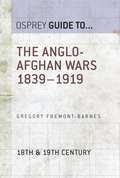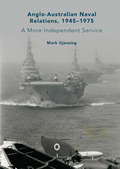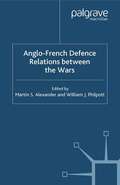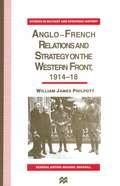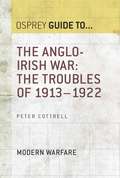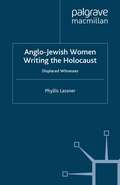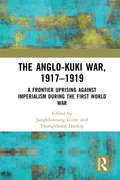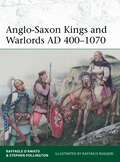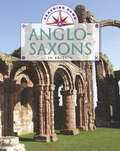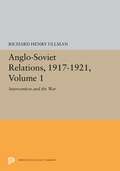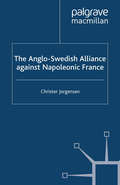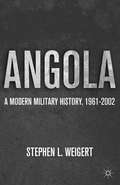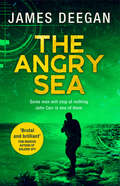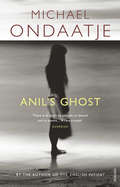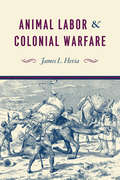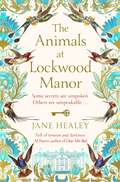- Table View
- List View
Angel's Peak: Forbidden Falls Angel's Peak Moonlight Road Midnight Confessions (A Virgin River Novel #9)
by Robyn CarrVirgin River – now a Netflix Original series Virgin River – Book 9 Can they overcome their past to look to the future
The Anglo-Afghan Wars 1839–1919 (Guide to...)
by Gregory Fremont-BarnesDuring the 19th century Britain entered into three brutal wars with Afghanistan, each one saw the British trying and failing to gain control of a warlike and impenetrable territory. The first two wars (1839–42 and 1878–81) were wars of the Great Game; the British Empire's attempts to combat growing Russian influence near India's borders. The third, fought in 1919, was an Afghan-declared holy war against British India – in which over 100,000 Afghans answered the call, and raised a force that would prove too great for the British Imperial army. Each of the three wars were plagued by military disasters, lengthy sieges and costly engagements for the British, and history has proved the Afghans a formidable foe and their country unconquerable. This book reveals the history of these three Anglo-Afghan wars, the imperial power struggles that led to conflict and the torturous experiences of the men on the ground. The book concludes with a brief overview of the background to today's conflict in Afghanistan, and sketches the historical parallels.
Anglo-Australian Naval Relations, 1945–1975: A More Independent Service
by Mark GjessingThis book examines Anglo-Australian naval relations between 1945-75, a period of great change for both Australia and Great Britain and their respective navies. It explores the cultural and historical ties between the Royal Navy and the Royal Australian Navy (RAN), the efficacy of communications between the services, and the importance of personal relations to the overall inter-service relationship. The author assesses the dilemmas faced by Great Britain associated with that nation’s declining power, and the impact of the retreat from ‘East of Suez’ on the strategic relationship between the United Kingdom and Australia. The book also considers operational co-operation between the Royal Navy and the RAN including conflicts such as the Korean War, the Malayan Emergency, and confrontation with Indonesia, as well as peacetime pursuits such as port visits and the testing of atomic weapons in the 1950s. Co-operation in matters of personnel and training are also dealt with in great detail, along with the co-operation between the Royal Navy and the RAN in equipment procurement and design and the increased ability of the RAN to look to non-British sources for equipment procurement. The book considers the impact of stronger Australian-American ties on the RAN and appraises the role it played in the conflict in Vietnam.
Anglo-Australian Naval Relations, 1945–1975 (PDF)
by Mark GjessingThis book examines Anglo-Australian naval relations between 1945-75, a period of great change for both Australia and Great Britain and their respective navies. It explores the cultural and historical ties between the Royal Navy and the Royal Australian Navy (RAN), the efficacy of communications between the services, and the importance of personal relations to the overall inter-service relationship. The author assesses the dilemmas faced by Great Britain associated with that nation’s declining power, and the impact of the retreat from ‘East of Suez’ on the strategic relationship between the United Kingdom and Australia. The book also considers operational co-operation between the Royal Navy and the RAN including conflicts such as the Korean War, the Malayan Emergency, and confrontation with Indonesia, as well as peacetime pursuits such as port visits and the testing of atomic weapons in the 1950s. Co-operation in matters of personnel and training are also dealt with in great detail, along with the co-operation between the Royal Navy and the RAN in equipment procurement and design and the increased ability of the RAN to look to non-British sources for equipment procurement. The book considers the impact of stronger Australian-American ties on the RAN and appraises the role it played in the conflict in Vietnam.
Anglo-French Defence Relations Between the Wars (Studies in Military and Strategic History)
by M. Alexander W. PhilpottThis collection of essays reviews the politico-military relationship between Britain and France between the two World Wars. As well as examining the relationship between the two nations' armed services, the book's contributors also analyse key themes in Anglo-French inter-war defence politics - disarmament, intelligence and imperial defence - and joint military, political and economic preparations for a second world war.
Anglo-French Relations and Strategy on the Western Front, 1914–18 (Studies in Military and Strategic History)
by William J. PhilpottThis book is a study of Anglo-French relations and military policy making in the First World War, which considers the strategic policies and operational planning of the British and French armies in the joint campaign fought on the western front. It examines the influence of incompatible British and French strategic objectives, the role of the allies' military and political leaders and the institutional development of the military alliance, on the alliance relationship and military policy making.
The Anglo-Irish War: The Troubles of 1913–1922 (Guide to...)
by Peter CottrellThe Anglo-Irish War has often been referred to as the war 'the English have struggled to forget and the Irish cannot help but remember'. Before 1919, the issue of Irish Home Rule lurked beneath the surface of Anglo-Irish relations for many years, but after the Great War, tensions rose up and boiled over. Irish Nationalists in the shape of Sinn Féin and the IRA took political power in 1919 with a manifesto to claim Ireland back from an English 'foreign' government by whatever means necessary. This book explores the conflict and the years that preceded it, examining such historic events as the Easter Rising and the infamous Bloody Sunday.
Anglo-Jewish Women Writing the Holocaust: Displaced Witnesses
by P. LassnerIn its analysis of Anglo-Jewish women writing the Holocaust, this book highlights the necessity of their inclusion in the evolving canon of modern British literature, by showing how these writers complicate theories of trauma and memory by using fantasy and the Gothic as a response to silence.
The Anglo-Kuki War, 1917–1919: A Frontier Uprising against Imperialism during the First World War
by Jangkhomang Guite Thongkholal HaokipThis book explores the Kuki uprising against the British Empire during the First World War in Northeast frontier of India (then Assam-Burma frontier). It underlines how of the three-year war (1917–1919), spanning over 6,000 square miles, is crucial to understanding present-day Northeast India. The essays in the volume examine several aspects of the war, which had far-reaching consequences for the indigenous population as well as for British attitudes and policy towards the region – including military strategy and tactics, violence, politics, identity, institutions, gender, culture, and the frontier dimensions of the First World War itself. The volume also looks at how the conflict affected the larger dynamics of the region within Asia, and its relevance in world politics beyond the Great War. Drawing on archival sources, extensive fieldwork and oral histories, the volume will be a significant contribution to comprehending the complex geopolitics of the region. It will be of great interest to scholars and researchers of South and Southeast Asian Studies, area studies, modern history, military and strategic studies, insurgency and counterinsurgency studies, tribal warfare and politics.
The Anglo-Kuki War, 1917–1919: A Frontier Uprising against Imperialism during the First World War
by Jangkhomang Guite Thongkholal HaokipThis book explores the Kuki uprising against the British Empire during the First World War in Northeast frontier of India (then Assam-Burma frontier). It underlines how of the three-year war (1917–1919), spanning over 6,000 square miles, is crucial to understanding present-day Northeast India. The essays in the volume examine several aspects of the war, which had far-reaching consequences for the indigenous population as well as for British attitudes and policy towards the region – including military strategy and tactics, violence, politics, identity, institutions, gender, culture, and the frontier dimensions of the First World War itself. The volume also looks at how the conflict affected the larger dynamics of the region within Asia, and its relevance in world politics beyond the Great War. Drawing on archival sources, extensive fieldwork and oral histories, the volume will be a significant contribution to comprehending the complex geopolitics of the region. It will be of great interest to scholars and researchers of South and Southeast Asian Studies, area studies, modern history, military and strategic studies, insurgency and counterinsurgency studies, tribal warfare and politics.
Anglo-Saxon Kings and Warlords AD 400–1070 (Elite #253)
by Dr Raffaele D’Amato Stephen PollingtonRichly illustrated, this title describes Anglo-Saxon monarchs, warlords and their warriors and households in Anglo-Saxon Britain, from the first post-Roman mercenaries to the Norman Conquest.In a country fragmented by Roman withdrawal during the 5th century AD, the employment of Germanic mercenaries by local rulers in Anglo-Saxon Britain was commonplace. These mercenaries became settlers, forcing Romano-British communities into Wales and the West Country. Against a background of spreading Christianity, the struggles of rival British and Anglo-Saxon kingdoms were exploited by the Vikings, but eventually contained by the Anglo-Saxon king, Alfred of Wessex. His descendants unified the country during the 10th century, however, subsequent weak rule saw its 25-year incorporation into a Danish empire before it finally fell to the Norman invasion of 1066. Scholars of the early Church have long known that the term 'Dark Ages' for the 5th to 11th centuries in Britain refers only to a lack of written sources, and gives a false impression of material culture. The Anglo-Saxon warrior elite were equipped with magnificent armour, influenced by the cultures of the late Romans, the Scandinavian Vendel people, the Frankish Merovingians, Carolingians and Ottonians, and also the Vikings. In this volume, co-authors Raffaele D'Amato and Stephen Pollington access their extended knowledge to paint a vivid picture of the kings and warlords of the time with the aid of colour illustrations, rare photos and the latest archaeological research.
Anglo-Saxon Kings and Warlords AD 400–1070 (Elite #253)
by Dr Raffaele D’Amato Stephen PollingtonRichly illustrated, this title describes Anglo-Saxon monarchs, warlords and their warriors and households in Anglo-Saxon Britain, from the first post-Roman mercenaries to the Norman Conquest.In a country fragmented by Roman withdrawal during the 5th century AD, the employment of Germanic mercenaries by local rulers in Anglo-Saxon Britain was commonplace. These mercenaries became settlers, forcing Romano-British communities into Wales and the West Country. Against a background of spreading Christianity, the struggles of rival British and Anglo-Saxon kingdoms were exploited by the Vikings, but eventually contained by the Anglo-Saxon king, Alfred of Wessex. His descendants unified the country during the 10th century, however, subsequent weak rule saw its 25-year incorporation into a Danish empire before it finally fell to the Norman invasion of 1066. Scholars of the early Church have long known that the term 'Dark Ages' for the 5th to 11th centuries in Britain refers only to a lack of written sources, and gives a false impression of material culture. The Anglo-Saxon warrior elite were equipped with magnificent armour, influenced by the cultures of the late Romans, the Scandinavian Vendel people, the Frankish Merovingians, Carolingians and Ottonians, and also the Vikings. In this volume, co-authors Raffaele D'Amato and Stephen Pollington access their extended knowledge to paint a vivid picture of the kings and warlords of the time with the aid of colour illustrations, rare photos and the latest archaeological research.
The Anglo-Saxons in Britain: The Anglo-saxons In Britain (Tracking Down #15)
by Moira Burretfield'The past is all around us, if we know where to look.' This series takes a look at archaeological, structural and museum evidence from around Britain, allowing readers to build up a picture of what life was like in key historical periods and how you can discover it for yourself by visiting sites around the country.
Anglo-Soviet Relations, 1917-1921, Volume 1: Intervention and the War (Princeton Legacy Library #5378)
by Richard Henry UllmanIn an intriguing work based largely on new sources, Richard H. Ullman shows how the British government--the politicians, civil servants, military and naval officers--dealt with the problem of Russia during the critical period bewtween the Bolshevik Revolution in November 1917 and Britain's de facto recognition of the Soviet government in March 1921.Volume 1 describes the tragic misunderstandings and desperate hopes of the British in the troubled year before the Armistice, which stands as a watershed in the history of Anglo-Soviet policy. As diplomacy failed, British forces found themselves fighting not only in North Russia but in the Caucasus and on the frontiers of India. The second volume, to be published later, will cover the story to 1921. Dr. Ullman's exciting portrayal of these evetns is a companion work to George Kennan's several-volume study of the same period, "Soviet-American Relations, 1917-1920."Originally published in 1961.The Princeton Legacy Library uses the latest print-on-demand technology to again make available previously out-of-print books from the distinguished backlist of Princeton University Press. These editions preserve the original texts of these important books while presenting them in durable paperback and hardcover editions. The goal of the Princeton Legacy Library is to vastly increase access to the rich scholarly heritage found in the thousands of books published by Princeton University Press since its founding in 1905.
The Anglo-Swedish Alliance Against Napoleonic France
by C. JorgensenThis new study by Christer Jorgensen addresses a much neglected field of study in the history of Scandinavia and the greater Baltic region during the Napoleonic Age. The book concentrates upon relations and the alliance between Britain and Sweden during the middle years of the war; years that encompassed the Austerlitz campaign, the complicated diplomatic talks between the allies, Russia's abandonment of the allied cause at Tilsit (1807), the Russo-Swedish War (1808-09) that decided the fate of Finland, the capitulation of the Gibraltar of the North, and finally the turbulent politics of Sweden during and after the coup of March 1809.
Angola: A Modern Military History, 1961-2002
by S. WeigertThis study is the first comprehensive assessment of warfare in Angola to cover all three phases of the nation's modern history: the anti-colonial struggle, the Cold War phase, and the post-Cold War era. It also covers, in detail, the final phase of warfare in Angola, culminating in Jonas Savimbi's death and the signing of the Luena Accord
The Angry Sea (John Carr #2)
by James Deegan‘Brutal and brilliant’ Tom Marcus, author of SOLDIER SPY
Anil's Ghost (Basic Ser.)
by Michael OndaatjeAnil's Ghost transports us to Sri Lanka, a country steeped in centuries of tradition, now forced into the late twentieth century by the ravages of a bloody civil war. Enter Anil Tissera, a young woman and forensic anthropologist born in Sri Lanka but educted in the West, sent by an international human rights group to identify the victims of the murder campaigns sweeping the island.When Anil discovers that the bones found in an ancient burial site are in fact those of a much more recent victim, her search for the terrible truth hidden in her homeland begins. What follows is a story about love, about family, about identity - a story driven by a riventing mystery.
Animal Labor and Colonial Warfare
by James L. HeviaUntil well into the twentieth century, pack animals were the primary mode of transport for supplying armies in the field. The British Indian Army was no exception. In the late nineteenth century, for example, it forcibly pressed into service thousands of camels of the Indus River basin to move supplies into and out of contested areas—a system that wreaked havoc on the delicately balanced multispecies environment of humans, animals, plants, and microbes living in this region of Northwest India. In Animal Labor and Colonial Warfare, James Hevia examines the use of camels, mules, and donkeys in colonial campaigns of conquest and pacification, starting with the Second Afghan War—during which an astonishing 50,000 to 60,000 camels perished—and ending in the early twentieth century. Hevia explains how during the nineteenth and twentieth centuries a new set of human-animal relations were created as European powers and the United States expanded their colonial possessions and attempted to put both local economies and ecologies in the service of resource extraction. The results were devastating to animals and human communities alike, disrupting centuries-old ecological and economic relationships. And those effects were lasting: Hevia shows how a number of the key issues faced by the postcolonial nation-state of Pakistan—such as shortages of clean water for agriculture, humans, and animals, and limited resources for dealing with infectious diseases—can be directly traced to decisions made in the colonial past. An innovative study of an underexplored historical moment, Animal Labor and Colonial Warfare opens up the animal studies to non-Western contexts and provides an empirically rich contribution to the emerging field of multispecies historical ecology.
Animal Labor and Colonial Warfare
by James L. HeviaUntil well into the twentieth century, pack animals were the primary mode of transport for supplying armies in the field. The British Indian Army was no exception. In the late nineteenth century, for example, it forcibly pressed into service thousands of camels of the Indus River basin to move supplies into and out of contested areas—a system that wreaked havoc on the delicately balanced multispecies environment of humans, animals, plants, and microbes living in this region of Northwest India. In Animal Labor and Colonial Warfare, James Hevia examines the use of camels, mules, and donkeys in colonial campaigns of conquest and pacification, starting with the Second Afghan War—during which an astonishing 50,000 to 60,000 camels perished—and ending in the early twentieth century. Hevia explains how during the nineteenth and twentieth centuries a new set of human-animal relations were created as European powers and the United States expanded their colonial possessions and attempted to put both local economies and ecologies in the service of resource extraction. The results were devastating to animals and human communities alike, disrupting centuries-old ecological and economic relationships. And those effects were lasting: Hevia shows how a number of the key issues faced by the postcolonial nation-state of Pakistan—such as shortages of clean water for agriculture, humans, and animals, and limited resources for dealing with infectious diseases—can be directly traced to decisions made in the colonial past. An innovative study of an underexplored historical moment, Animal Labor and Colonial Warfare opens up the animal studies to non-Western contexts and provides an empirically rich contribution to the emerging field of multispecies historical ecology.
Animal Labor and Colonial Warfare
by James L. HeviaUntil well into the twentieth century, pack animals were the primary mode of transport for supplying armies in the field. The British Indian Army was no exception. In the late nineteenth century, for example, it forcibly pressed into service thousands of camels of the Indus River basin to move supplies into and out of contested areas—a system that wreaked havoc on the delicately balanced multispecies environment of humans, animals, plants, and microbes living in this region of Northwest India. In Animal Labor and Colonial Warfare, James Hevia examines the use of camels, mules, and donkeys in colonial campaigns of conquest and pacification, starting with the Second Afghan War—during which an astonishing 50,000 to 60,000 camels perished—and ending in the early twentieth century. Hevia explains how during the nineteenth and twentieth centuries a new set of human-animal relations were created as European powers and the United States expanded their colonial possessions and attempted to put both local economies and ecologies in the service of resource extraction. The results were devastating to animals and human communities alike, disrupting centuries-old ecological and economic relationships. And those effects were lasting: Hevia shows how a number of the key issues faced by the postcolonial nation-state of Pakistan—such as shortages of clean water for agriculture, humans, and animals, and limited resources for dealing with infectious diseases—can be directly traced to decisions made in the colonial past. An innovative study of an underexplored historical moment, Animal Labor and Colonial Warfare opens up the animal studies to non-Western contexts and provides an empirically rich contribution to the emerging field of multispecies historical ecology.
Animal Labor and Colonial Warfare
by James L. HeviaUntil well into the twentieth century, pack animals were the primary mode of transport for supplying armies in the field. The British Indian Army was no exception. In the late nineteenth century, for example, it forcibly pressed into service thousands of camels of the Indus River basin to move supplies into and out of contested areas—a system that wreaked havoc on the delicately balanced multispecies environment of humans, animals, plants, and microbes living in this region of Northwest India. In Animal Labor and Colonial Warfare, James Hevia examines the use of camels, mules, and donkeys in colonial campaigns of conquest and pacification, starting with the Second Afghan War—during which an astonishing 50,000 to 60,000 camels perished—and ending in the early twentieth century. Hevia explains how during the nineteenth and twentieth centuries a new set of human-animal relations were created as European powers and the United States expanded their colonial possessions and attempted to put both local economies and ecologies in the service of resource extraction. The results were devastating to animals and human communities alike, disrupting centuries-old ecological and economic relationships. And those effects were lasting: Hevia shows how a number of the key issues faced by the postcolonial nation-state of Pakistan—such as shortages of clean water for agriculture, humans, and animals, and limited resources for dealing with infectious diseases—can be directly traced to decisions made in the colonial past. An innovative study of an underexplored historical moment, Animal Labor and Colonial Warfare opens up the animal studies to non-Western contexts and provides an empirically rich contribution to the emerging field of multispecies historical ecology.
Animal Labor and Colonial Warfare
by James L. HeviaUntil well into the twentieth century, pack animals were the primary mode of transport for supplying armies in the field. The British Indian Army was no exception. In the late nineteenth century, for example, it forcibly pressed into service thousands of camels of the Indus River basin to move supplies into and out of contested areas—a system that wreaked havoc on the delicately balanced multispecies environment of humans, animals, plants, and microbes living in this region of Northwest India. In Animal Labor and Colonial Warfare, James Hevia examines the use of camels, mules, and donkeys in colonial campaigns of conquest and pacification, starting with the Second Afghan War—during which an astonishing 50,000 to 60,000 camels perished—and ending in the early twentieth century. Hevia explains how during the nineteenth and twentieth centuries a new set of human-animal relations were created as European powers and the United States expanded their colonial possessions and attempted to put both local economies and ecologies in the service of resource extraction. The results were devastating to animals and human communities alike, disrupting centuries-old ecological and economic relationships. And those effects were lasting: Hevia shows how a number of the key issues faced by the postcolonial nation-state of Pakistan—such as shortages of clean water for agriculture, humans, and animals, and limited resources for dealing with infectious diseases—can be directly traced to decisions made in the colonial past. An innovative study of an underexplored historical moment, Animal Labor and Colonial Warfare opens up the animal studies to non-Western contexts and provides an empirically rich contribution to the emerging field of multispecies historical ecology.
Animal Labor and Colonial Warfare
by James L. HeviaUntil well into the twentieth century, pack animals were the primary mode of transport for supplying armies in the field. The British Indian Army was no exception. In the late nineteenth century, for example, it forcibly pressed into service thousands of camels of the Indus River basin to move supplies into and out of contested areas—a system that wreaked havoc on the delicately balanced multispecies environment of humans, animals, plants, and microbes living in this region of Northwest India. In Animal Labor and Colonial Warfare, James Hevia examines the use of camels, mules, and donkeys in colonial campaigns of conquest and pacification, starting with the Second Afghan War—during which an astonishing 50,000 to 60,000 camels perished—and ending in the early twentieth century. Hevia explains how during the nineteenth and twentieth centuries a new set of human-animal relations were created as European powers and the United States expanded their colonial possessions and attempted to put both local economies and ecologies in the service of resource extraction. The results were devastating to animals and human communities alike, disrupting centuries-old ecological and economic relationships. And those effects were lasting: Hevia shows how a number of the key issues faced by the postcolonial nation-state of Pakistan—such as shortages of clean water for agriculture, humans, and animals, and limited resources for dealing with infectious diseases—can be directly traced to decisions made in the colonial past. An innovative study of an underexplored historical moment, Animal Labor and Colonial Warfare opens up the animal studies to non-Western contexts and provides an empirically rich contribution to the emerging field of multispecies historical ecology.
The Animals at Lockwood Manor
by Jane HealeySome secrets are unspoken. Others are unspeakable . . . August 1939. Thirty-year-old Hetty Cartwright is tasked with the evacuation and safekeeping of the natural history museum’s collection of mammals. Once she and her exhibits arrive at Lockwood Manor, however, where they are to stay for the duration of the war, Hetty soon realizes that she’s taken on more than she’d bargained for. Protecting her charges from the irascible Lord Lockwood and resentful servants is work enough, but when some of the animals go missing, and worse, Hetty begins to suspect someone – or something – is stalking her through the darkened corridors of the house. As the disasters mount, Hetty finds herself falling under the spell of Lucy, Lord Lockwood’s beautiful but clearly haunted daughter. But why is Lucy so traumatized? Does she know something she’s not telling? And is there any truth to local rumours of ghosts and curses? Part love story, part mystery, The Animals at Lockwood Manor by Jane Healey is a gripping and atmospheric tale of family madness, long-buried secrets and hidden desires.

